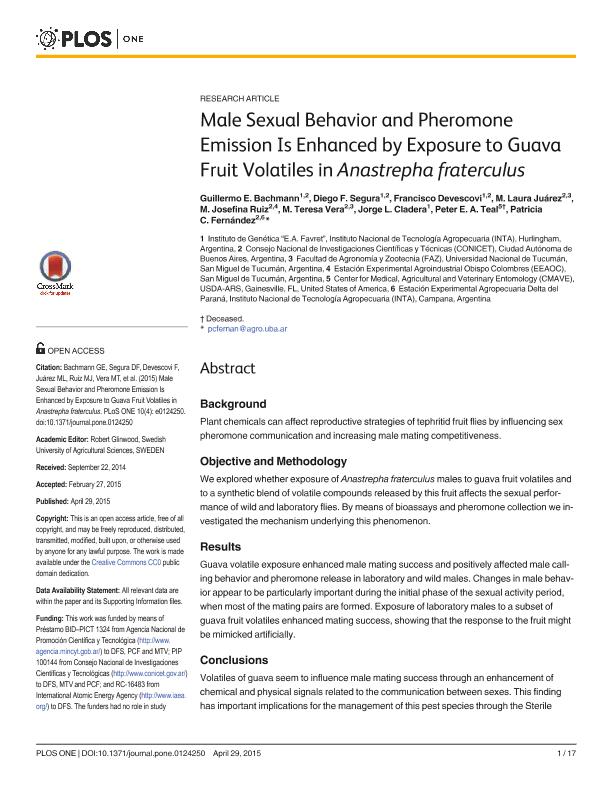Mostrar el registro sencillo del ítem
dc.contributor.author
Bachmann, Guillermo Enrique

dc.contributor.author
Segura, Diego Fernando

dc.contributor.author
Devescovi, Francisco

dc.contributor.author
Juárez, María Laura

dc.contributor.author
Ruiz, María Josefina

dc.contributor.author
Vera, María Teresa

dc.contributor.author
Cladera, Jorge Luis

dc.contributor.author
Teal, Peter E. A.
dc.contributor.author
Fernandez, Patricia Carina

dc.date.available
2020-09-03T17:52:36Z
dc.date.issued
2015-04
dc.identifier.citation
Bachmann, Guillermo Enrique; Segura, Diego Fernando; Devescovi, Francisco; Juárez, María Laura; Ruiz, María Josefina; et al.; Male Sexual Behavior and Pheromone Emission Is Enhanced by Exposure to Guava Fruit Volatiles in Anastrepha fraterculus; Public Library of Science; Plos One; 10; 4; 4-2015; 1-17
dc.identifier.issn
1932-6203
dc.identifier.uri
http://hdl.handle.net/11336/113141
dc.description.abstract
Background: Plant chemicals can affect reproductive strategies of tephritid fruit flies by influencing sex pheromone communication and increasing male mating competitiveness. Objective and Methodology: We explored whether exposure of Anastrepha fraterculus males to guava fruit volatiles and to a synthetic blend of volatile compounds released by this fruit affects the sexual performance of wild and laboratory flies. By means of bioassays and pheromone collection we investigated the mechanism underlying this phenomenon. Results: Guava volatile exposure enhanced male mating success and positively affected male calling behavior and pheromone release in lab and wild males. Changes in male behavior appear to be particularly important during the initial phase of the sexual activity period, when most of the mating pairs are formed. Exposure of laboratory males to a subset of guava fruit volatiles enhanced mating success, showing that the response to the fruit might be mimicked artificially. Conclusions: Volatiles of guava seem to influence male mating competitiveness through an enhancement of chemical and physical signals related to the communication between sexes. This finding has important implications for the management of this pest species through the Sterile Insect Technique. We discuss the possibility of using artificial blends to improve the sexual competitiveness of sterile males.
dc.format
application/pdf
dc.language.iso
eng
dc.publisher
Public Library of Science

dc.rights
info:eu-repo/semantics/openAccess
dc.rights.uri
https://creativecommons.org/licenses/by-nc-sa/2.5/ar/
dc.subject
SOUTH AMERICAN FRUIT FLY
dc.subject
PHEROMONE
dc.subject
SEXUAL ENHANCEMENT
dc.subject
MATING COMPETITIVENESS
dc.subject
GUAVA
dc.subject
FRUIT VOLATILES
dc.subject
TEPHRITIDAE
dc.subject
STERILE INSECT TECHNIQUE
dc.subject
SEXUAL COMPETITIVENESS ENHANCERS
dc.subject
HOST PLANT CHEMICALS
dc.subject
PSIDIUM GUAJABA
dc.subject.classification
Zoología, Ornitología, Entomología, Etología

dc.subject.classification
Ciencias Biológicas

dc.subject.classification
CIENCIAS NATURALES Y EXACTAS

dc.title
Male Sexual Behavior and Pheromone Emission Is Enhanced by Exposure to Guava Fruit Volatiles in Anastrepha fraterculus
dc.type
info:eu-repo/semantics/article
dc.type
info:ar-repo/semantics/artículo
dc.type
info:eu-repo/semantics/publishedVersion
dc.date.updated
2020-09-02T18:33:02Z
dc.journal.volume
10
dc.journal.number
4
dc.journal.pagination
1-17
dc.journal.pais
Estados Unidos

dc.journal.ciudad
San Francisco
dc.description.fil
Fil: Bachmann, Guillermo Enrique. Consejo Nacional de Investigaciones Científicas y Técnicas; Argentina. Instituto Nacional de Tecnología Agropecuaria. Centro de Investigación en Ciencias Veterinarias y Agronómicas. Instituto de Genética; Argentina
dc.description.fil
Fil: Segura, Diego Fernando. Consejo Nacional de Investigaciones Científicas y Técnicas; Argentina. Instituto Nacional de Tecnología Agropecuaria. Centro de Investigación en Ciencias Veterinarias y Agronómicas. Instituto de Genética; Argentina
dc.description.fil
Fil: Devescovi, Francisco. Consejo Nacional de Investigaciones Científicas y Técnicas; Argentina. Instituto Nacional de Tecnología Agropecuaria. Centro de Investigación en Ciencias Veterinarias y Agronómicas. Instituto de Genética; Argentina
dc.description.fil
Fil: Juárez, María Laura. Universidad Nacional de Tucumán; Argentina. Consejo Nacional de Investigaciones Científicas y Técnicas; Argentina
dc.description.fil
Fil: Ruiz, María Josefina. Consejo Nacional de Investigaciones Científicas y Técnicas; Argentina. Provincia de Tucumán. Ministerio de Desarrollo Productivo. Estación Experimental Agroindustrial "Obispo Colombres" (P); Argentina
dc.description.fil
Fil: Vera, María Teresa. Consejo Nacional de Investigaciones Científicas y Técnicas; Argentina. Universidad Nacional de Tucumán; Argentina
dc.description.fil
Fil: Cladera, Jorge Luis. Instituto Nacional de Tecnología Agropecuaria. Centro de Investigación en Ciencias Veterinarias y Agronómicas. Instituto de Genética; Argentina. Consejo Nacional de Investigaciones Científicas y Técnicas; Argentina
dc.description.fil
Fil: Teal, Peter E. A.. No especifíca;
dc.description.fil
Fil: Fernandez, Patricia Carina. Consejo Nacional de Investigaciones Científicas y Técnicas; Argentina. Instituto Nacional de Tecnología Agropecuaria. Centro Regional Buenos Aires Norte. Estación Experimental Agropecuaria Delta del Paraná; Argentina
dc.journal.title
Plos One

dc.relation.alternativeid
info:eu-repo/semantics/altIdentifier/url/http://journals.plos.org/plosone/article?id=10.1371/journal.pone.0124250
dc.relation.alternativeid
info:eu-repo/semantics/altIdentifier/doi/http://dx.doi.org/10.1371/journal.pone.0124250
Archivos asociados
